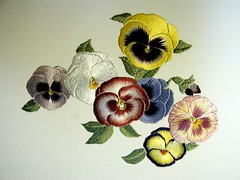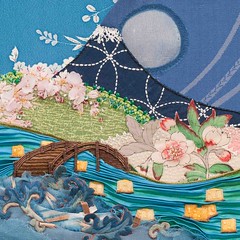If you had to stitch 118 goldwork leaves on a honeysuckle vine, how many leaves do you think it would take before you felt like they began to flow from your needle?
All of the leaves on this honeysuckle vine have a very predictable shape so it shouldn't take too long, right?
Oh, if it were only that easy. There are so many variables to account for and I am only now beginning to find a rhythm...on leaf number 86.
Working with Japanese gold thread, couching stitches every 2mm or so, maintaining the twist of the gold, manipulating the koma in a predictable and practiced way, making good corners, etc.
There's a lot to understand. First, the thread.
Japanese gold thread comes in a hank and it must be split in half and wound onto two wooden spools called koma. It is very important that the thread be wound onto the spool under tension. I am using size number 3 and it's imitation gold...

To understand the importance of having the thread under tension, you have to understand how the thread is made. Gold (real or imitation) is laminated to mulberry paper, cut into strips and then wrapped around a silk core.
While stitching, the wraps can become loose allowing more of the silk core to show through. This also makes the thread less taut and more wimpy.
Here is a picture of the gold thread that has loosened near the cut end...

By winding the koma, I can tighten and untighten the twist of the thread. In the picture below, I have tightened the gold thread; the wraps are closer together and the thread takes on a wire-like quality.

This is how you want the thread to be when you couch it down. The gold thread shines to optimal effect when the thread is laid this way.
That being said, to turn corners the thread needs to be softened in order to make sharp points and corners. My honeysuckle leaves don't require as sharp a corners as my cherry blossom petals but I still have many corners to turn. Softening the twist of the gold at the turn keeps the thread from crimping. Once I've made the turn, I have to retighten the twist of the thread again and off I go to the next turn.
This means that there is a constant manipulation of the thread wrapped around the koma as I stitch. Wrapping to tighten the thread, couching the thread, and then loosening the wraps at the corner to allow for an easier turn, and then tightening the thread again to couch down the straightaway section of the leaf.

This dance of the koma, together with the starting and ending the threads for each leaf, means that each leaf can take a good deal of time. For me, about 22 minutes. (*wink* That's what that Toggl timer is for).
Next Japanese embroidery post, I'll try to post some pictures of turning corners since a few of you have asked about that.
Needless to say, these koma are very handy tools and I use them anytime I need to couch a non-stitchable thread on a project. This extra set of hands allows you to keep your thread under good tension so that the couched line is nice and smooth.
Koma are most often sold in pairs and can be made from a variety of woods. The most important thing when selecting koma is the weight of the wood that is used. The heavier the better.
The weight plus the squared off ends keeps the spool from rolling and helps to anchor the koma firmly in place. They really are like a second pair of hands.
You can buy koma from the Japanese embroidery center here .

But don't expect to master their use overnight.
Hundreds of curlicues...118 leaves, and hundreds more turns...
Practice is the teacher.
That's one thing that the Japanese understand. Ten phases to teach you. To test you. And then you are ready to begin.
The hardest part for me is staying in the chair. Resisting the temptation to do something else. And no, it doesn't get easier.
Showing up. Sitting down. Keeping my butt in the chair. Stitching for a minimum of two hours every day.
It's starting to happen. Competence. Predictability. Flow.
The Japanese understand that there are no short cuts to gaining skill. It's work; it can be hard.
I'm getting better at the struggle. I'm winning more and more. My butt is staying in the chair.


































































